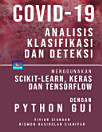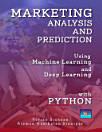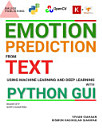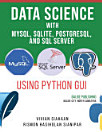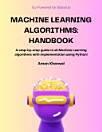OPINION MINING AND PREDICTION USING MACHINE LEARNING AND DEEP LEARNING WITH PYTHON GUI
About this ebook
To tackle sentiment classification, we employed a range of machine learning algorithms, including Support Vector, Logistic Regression, K-Nearest Neighbours Classiier, Decision Tree,
Random Forest Classifier, Gradient Boosting, Extreme Gradient Boosting, Light Gradient Boosting, and Adaboost Classifiers. These algorithms were combined with different vectorization techniques such as Hashing Vectorizer, Count Vectorizer, and TF-IDF Vectorizer. By converting text data into numerical representations, these models were trained and evaluated to identify the most effective combination for sentiment classification.
In addition to traditional machine learning algorithms, we explored the power of recurrent neural networks (RNNs) and their variant, Long Short-Term Memory (LSTM). LSTM is particularly adept at capturing contextual dependencies and handling sequential data. The text data was tokenized and padded to ensure consistent input length, allowing the LSTM model to learn from the sequential nature of the text. Performance metrics, including accuracy, were used to evaluate the model's ability to classify sentiments accurately.
Furthermore, we delved into Convolutional Neural Networks (CNNs), another deep learning model known for its ability to extract meaningful features. The text data was preprocessed and transformed into numerical representations suitable for CNN input. The architecture of the CNN model, consisting of embedding, convolutional, pooling, and dense layers, facilitated the extraction of relevant features and the classification of sentiments.
Analyzing the results of our machine learning models, we gained insights into their effectiveness in sentiment classification. We observed the accuracy and performance of various algorithms and vectorization techniques, enabling us to identify the models that achieved the highest accuracy and overall performance. LSTM and CNN, being more advanced models, aimed to capture complex patterns and dependencies in the text data, potentially resulting in improved sentiment classification.
Monitoring the training history and metrics of the LSTM and CNN models provided valuable insights. We examined the learning progress, convergence behavior, and generalization capabilities of the models. Through the evaluation of performance metrics and convergence trends, we gained an understanding of the models' ability to learn from the data and make accurate predictions.
Confusion matrices played a crucial role in assessing the models' predictions. They provided a detailed analysis of the models' classification performance, highlighting the distribution of correct and incorrect classifications for each sentiment category. This analysis allowed us to identify potential areas of improvement and fine-tune the models accordingly.
In addition to confusion matrices, visualizations comparing the true values with the predicted values were employed to evaluate the models' performance. These visualizations provided a comprehensive overview of the models' classification accuracy and potential areas for improvement. They allowed us to assess the alignment between the models' predictions and the actual sentiment labels, enabling a deeper understanding of the models' strengths and weaknesses.
Overall, the exploration of machine learning, LSTM, and CNN models for sentiment analysis and opinion mining aimed to develop effective tools for understanding public opinions. The results obtained from this project showcased the models' performance, convergence behavior, and their ability to accurately classify sentiments. These insights can be leveraged by businesses and organizations to gain a deeper understanding of the sentiments expressed towards their products or services, enabling them to make informed decisions and adapt their strategies accordingly.
Ratings and reviews
About the author
Vivian Siahaan is a fast-learner who likes to do new things. She was born, raised in Hinalang Bagasan, Balige, on the banks of Lake Toba, and completed high school education from SMAN 1 Balige. She started herself learning Java, Android, JavaScript, CSS, C ++, Python, R, Visual Basic, Visual C #, MATLAB, Mathematica, PHP, JSP, MySQL, SQL Server, Oracle, Access, and other programming languages. She studied programming from scratch, starting with the most basic syntax and logic, by building several simple and applicable GUI applications. Animation and games are fields of programming that are interests that she always wants to develop. Besides studying mathematical logic and programming, the author also has the pleasure of reading novels. Vivian Siahaan has written dozens of ebooks that have been published on Sparta Publisher: Data Structure with Java; Java Programming: Cookbook; C ++ Programming: Cookbook; C Programming For High Schools / Vocational Schools and Students; Java Programming for SMA / SMK; Java Tutorial: GUI, Graphics and Animation; Visual Basic Programming: From A to Z; Java Programming for Animation and Games; C # Programming for SMA / SMK and Students; MATLAB For Students and Researchers; Graphics in JavaScript: Quick Learning Series; JavaScript Image Processing Methods: From A to Z; Java GUI Case Study: AWT & Swing; Basic CSS and JavaScript; PHP / MySQL Programming: Cookbook; Visual Basic: Cookbook; C ++ Programming for High Schools / Vocational Schools and Students; Concepts and Practices of C ++; PHP / MySQL For Students; C # Programming: From A to Z; Visual Basic for SMA / SMK and Students; C # .NET and SQL Server for High School / Vocational School and Students. At the ANDI Yogyakarta publisher, Vivian Siahaan also wrote a number of books including: Python Programming Theory and Practice; Python GUI Programming; Python GUI and Database; Build From Zero School Database Management System In Python / MySQL; Database Management System in Python / MySQL; Python / MySQL For Management Systems of Criminal Track Record Database; Java / MySQL For Management Systems of Criminal Track Records Database; Database and Cryptography Using Java / MySQL; Build From Zero School Database Management System With Java / MySQL.
Rismon Hasiholan Sianipar was born in Pematang Siantar, in 1994. After graduating from SMAN 3 Pematang Siantar 3, the writer traveled to the city of Jogjakarta. In 1998 and 2001 the author completed his Bachelor of Engineering (S.T) and Master of Engineering (M.T) education in the Electrical Engineering of Gadjah Mada University, under the guidance of Prof. Dr. Adhi Soesanto and Prof. Dr. Thomas Sri Widodo, focusing on research on non-stationary signals by analyzing their energy using time-frequency maps. Because of its non-stationary nature, the distribution of signal energy becomes very dynamic on a time-frequency map. By mapping the distribution of energy in the time-frequency field using discrete wavelet transformations, one can design non-linear filters so that they can analyze the pattern of the data contained in it. In 2003, the author received a Monbukagakusho scholarship from the Japanese Government. In 2005 and 2008, he completed his Master of Engineering (M.Eng) and Doctor of Engineering (Dr.Eng) education at Yamaguchi University, under the guidance of Prof. Dr. Hidetoshi Miike. Both the master's thesis and his doctoral thesis, R.H. Sianipar combines SR-FHN (Stochastic Resonance Fitzhugh-Nagumo) filter strength with cryptosystem ECC (elliptic curve cryptography) 4096-bit both to suppress noise in digital images and digital video and maintain its authenticity. The results of this study have been documented in international scientific journals and officially patented in Japan. One of the patents was published in Japan with a registration number 2008-009549. He is active in collaborating with several universities and research institutions in Japan, particularly in the fields of cryptography, cryptanalysis and audio / image / video digital forensics. R.H. Sianipar also has experience in conducting code-breaking methods (cryptanalysis) on a number of intelligence data that are the object of research studies in Japan. R.H. Sianipar has a number of Japanese patents, and has written a number of national / international scientific articles, and dozens of national books. R.H. Sianipar has also participated in a number of workshops related to cryptography, cryptanalysis, digital watermarking, and digital forensics. In a number of workshops, R.H. Sianipar helps Prof. Hidetoshi Miike to create applications related to digital image / video processing, steganography, cryptography, watermarking, non-linear screening, intelligent descriptor-based computer vision, and others, which are used as training materials. Field of interest in the study of R.H. Sianipar is multimedia security, signal processing / digital image / video, cryptography, digital communication, digital forensics, and data compression / coding. Until now, R.H. Sianipar continues to develop applications related to analysis of signal, image, and digital video, both for research purposes and for commercial purposes based on the Python programming language, MATLAB, C ++, C, VB.NET, C # .NET, R, and Java.


